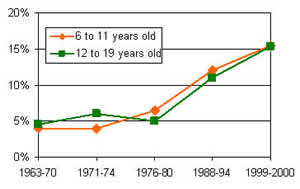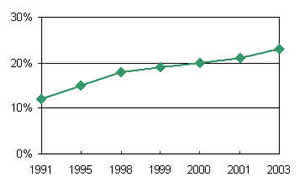|
Perhaps one of the most alarming trends plaguing our modern food system is the seemingly rampant increase in the prevalence of obesity across the United States. The Department of Health and Human Services reports that one in three adults is obese, and two out of three are considered overweight or obese. Even more alarming is the trend among children, where obesity rates have nearly tripled since 1980 (NCHS-CDC, 2006). Policy makers across the country have responded with efforts to drive foods of minimal nutritional value out of our schools and replace them with whole grains and fresh fruit and vegetables (Schmid, 2007; Zhang, 2007).
The resulting policies and programs may represent opportunities for marketers and producers of fresh fruit and vegetables to reach a growing market segment within our schools. However, it is not enough to simply provide an appealing product to students. Instead, successful marketers will appeal to the needs, perceptions, and preferences of those responsible for wholesale purchasing (Park, 2001). They need insight into the mentality of the school foodservice director. The effectiveness of these programs to improve dietary quality and presumably health is currently being debated. Externalities such as the influence of school foodservice buying habits and constraints may impact the effectiveness of these programs to achieve their stated objectives.
The Road to Obesity
To understand our present situation, let's step back and look at how we got to this point of a national health crisis. We believe that one major influence on our current predicament is the change that has occurred in our lifestyles. Think back fifty years ago—families generally consisted of two parents, and subsisted on one income. Family meals were prepared at home and enjoyed around the dinner table. The newspaper was a major avenue for the flow of information, and businesses competed with the guy across the street.
Fast forward to the present—the composition of the family unit has changed, as well as the economic conditions in which it operates. Today, meals of convenience are the norm, and businesses conduct operations on a global scale. Information is transmitted as quickly as ideas are developed. The widespread use of cell phones, text messaging, and the internet have compounded the amount of information available to an individual at any given point in time. Consequently, the modern consumer expects instant satisfaction and greatly values added services and conveniences. Not surprisingly, the food industry has shifted toward providing indulgent, value-added food products that are highly convenient (see Capps and Park, 2003, for further discussion of food marketing channels). When you put this together with the facts that U.S. consumers generally have less discretionary time, more discretionary income, and lead sedentary lifestyles, you get a recipe for obesity.
In a continual effort to provide consumers with products they want, food marketers are watching these trends closely. Some recent new product trends emphasize the use of wholegrain ingredients, while others offer portion control like Nabisco's "100 Calorie Packs." Even so, marketers continue to struggle to increase per capita consumption of fresh fruit and vegetables, despite continued reports on the associated health benefits (Wang & McKay, 2006). However, the public outcry over the poor state of school foodservice offerings may signal an opportunity for increased sales of fresh fruit and vegetables. In support of this, the government offers programs intended to improve the dietary intakes of school children while simultaneously supporting agricultural producers.
Back to School
Most (if not all) school districts have a foodservice director that is in charge of purchasing food for the students within the district. Although their primary concern is providing lunch, many schools also offer breakfast and snacks. The foodservice director will combine funds available from state and local government as well as federal programs. In general, he/she can purchase products from whatever source he/she chooses; however, participation in certain government programs requires purchasing specific products through specific sources of distribution.
A variety of programs are available to help foodservice directors procure food for their schools. Such programs include the National School Lunch Program (NSLP) and the National School Breakfast Program (NSBP) among others. The NSLP and NSBP differ from some food aid programs in that they are available, at a slightly higher cost, to children who may not qualify for poverty-based assistance. The spending of these program funds are typically administered by a state department of agriculture.
The National School Lunch Program (NSLP) is the major government program that foodservice directors use to purchase their lunch foods. The NSLP provides nutritionally balanced low-cost, or sometimes free lunches to millions of children each school day. Since the inception in 1946, daily student participation in NSLP has grown from 7.1 million to 29.6 million in 2005, with approximately 100,000 schools participating. With regards to the NSBP, daily participation has grown from 1.8 million children in 1975 to 9.3 million children in 2005, with approximately 83,000 schools participating. Based on the large number of students using the NSLP and NSBP daily, their influence on nutrition, both in consumption and in establishing life-long behaviors, could be considerable.
There are also other programs that exist to encourage the consumption of specific food products in school programs. The Fresh Fruit and Vegetable Program, instituted by the USDA, reimburses schools for their purchases of fresh fruit and vegetables outside of those purchased as part of the NSLP. Initially available in 8 states, the program has been expanded, but funds are limited. For example, in Texas this program was made available to only 24 of the 7,203 schools that are eligible to participate in NSLP.
The methods school districts use to implement these programs go beyond putting nutritional foods on the menu. Some schools make these products available on demand, throughout the day. Finally, many states have initiated Farm-to-School programs in conjunction with federal programs. These programs help to keep federal funds within the state economy by allowing schools to buy produce from local growers at subsidized prices, sometimes only paying the cost of delivery (TDA, 2006).
Program Effectiveness
As part of the Centers for Disease Control and Prevention, the National Center for Health Statistics collects data through various methods in an effort to document the health status of the U.S. population. The information they gather is also an important part of research efforts to evaluate health policies and programs. However, quality of health is a complex issue. It can be measured in many different ways and is impacted by many different factors. For that reason, there is an abundance of research examining the effectiveness of these programs to provide only selected groups of nutrients at any one time.
Currently, we are examining data from the National Health and Nutrition Examination Survey (NHANES) to see if the NSLP and NSBP actually improve the consumption of fresh fruit and vegetables among school age children. Since obesity is rising and a large number of students eat at least one meal (lunch) and perhaps two meals (lunch and breakfast) at school each day, measuring the effectiveness of the NSLP and NSBP is extremely important in order to determine if the current guidelines are having an effect on healthy eating habits, particularly related to the consumption of fruits and vegetables.
Some preliminary results suggest that student participation in only the NSLP has a positive impact on fresh fruit and vegetable consumption. However, student participation in the NSBP has a negative impact on fresh fruit and vegetable consumption (Campbell et al., 2007). Reasons behind these results are being investigated, but we need to remember that these results are influenced by the choices available to the students. For example, in the course of our research we were able to interview many different school foodservice directors. On one occasion, we ran across a reference to what foodservice personnel called "Hot Cheetos and cheese" that was sold to the students a la carte. The product involved taking a single serving bag of Flamin' Hot Cheetos (a popular brand of spicy extruded corn snack from Frito-Lay), pouring a scoop of melted nacho cheese over the contents, and putting a fork in it. This cheesy treat was a favorite among the students and provided the school district with sizeable revenue.
Although the product was admittedly unhealthy, the income that it generated gave the school district greater freedom and flexibility in operations. Any profit from the sale of a la carte items of this nature goes back to the district office, in essence increasing its budget. The rare opportunity of an actual profit center in a school foodservice program is a temptation that can completely undermine nutritional objectives. This illustrates how the factors surrounding the implementation of foodservice programs can confound the ability of national programs to achieve their stated goals. Further, we found it interesting that smaller nearby school districts also admitted to selling the Flamin' Hot Cheetos and cheese mixture, but stopped that practice due to nutritional concerns. From discussions with these foodservice directors, it was evident that their action might be due in part to a greater sense of accountability to parents and increased parental involvement with school administrators.
As a final note, researchers need to be aware of the Cheetos effect. Seemingly, conflicting results surrounding federal program initiatives may not be entirely due to the program, but also due to the conditions of its implementation. National surveys sometimes have difficulty in accounting for quality differences among the experiences of their respondents. In order to be more effective, policy makers and food marketers alike must be aware of the behavior of channel intermediaries like school administrators, in addition to the constraints they face.
For More Information
Campbell, B.L., Silva, A., Nayga, R.M., Jr., & Park, J.L. (2007). Do the national school lunch and school breakfast programs improve children's fresh fruit and vegetable consumption? A matching technique analysis. Working Paper, Department of Agricultural Economics, Texas A&M University.
Capps, O., Jr., & Park, J.L. (2003). Food retailing and food service. In Koontz, S. (ed.) Veterinary Clinics Food Animal Practice, 19, 445-61.
National Center of Health Statistics-Center for Disease Control (NCHS-CDC). (2006). Prevalence of overweight among children and adolescents: United States, 1999-2002. Revised Feb. 8, 2005. Available online: http://www.cdc.gov/nchs/products/pubs/pubd/hestats/ overwght99.htm (Accessed April 19, 2006).
Park, J.L. (2001). Supermarket product selection uncovered: Manufacturer promotions and the channel intermediary. International Food and Agribusiness Review, 4, 119-31.
Schmid, R.E. (2007). Standards urged for school snacks. Associated Press. Available online: http://news.yahoo.com/s/ap/20070425/ ap_on_he_me/diet_school_food_10.
Texas Department of Agriculture (TDA). (2005). Texas Selected for Fresh Fruit and Vegetable Program. News Release dated November 15, 2005. Austin, TX.
Wang, S., & McKay, B. (2006). More reasons to eat your veggies; Government revamps effort to boost consumption of produce as understanding of benefits grows. Wall Street Journal, (Eastern Edition). New York, NY: July 25, 2006, p. D.1.
Zhang, J. (2007). Proposal would tighten school-food standards. Wall Street Journal, (Eastern Edition). New York, NY: April 26, 2007, p. D.6.
|


